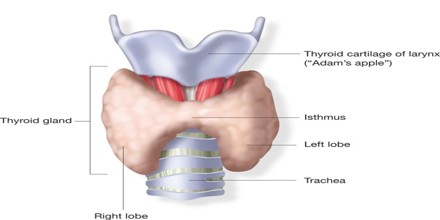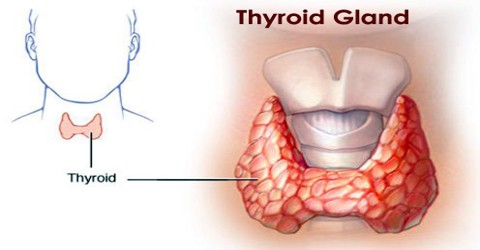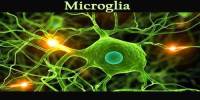Thyroid Gland
Definition
Thyroid Gland or also called Thyroid is situated at the front of the throat, below the larynx, and comprises two lobes that lie on either side of the windpipe. The thyroid gland secretes hormones to regulate many metabolic processes, including growth and energy expenditure. If the thyroid gland is overactive or sluggish, the metabolism will be affected, leading to a variety of symptoms that are easily misdiagnosed.

Thyroid Gland is a gland that makes and stores hormones that help regulate the heart rate, blood pressure, body temperature, and the rate at which food is converted into energy. The thyroid uses iodine, a mineral found in some foods and in iodized salt, to make its hormones. The two most important thyroid hormones are thyroxine (T4) and triiodothyronine (T3). Thyroid stimulating hormone (TSH), which is produced by the pituitary gland, acts to stimulate hormone production by the thyroid gland. The thyroid gland also makes the hormone calcitonin, which is involved in calcium metabolism and stimulating bone cells to add calcium to bone.
If there is too much T4 circulating in the blood, the pituitary reduces the amount of TSH produced, which then causes thyroid activity to slow. If there is too little T4, the pituitary increases the amount of TSH. In this way, T4 and T3 levels in the blood are kept relatively constant. The pituitary gland, in turn, is overseen by a part of the brain called the hypothalamus.

Thyroid Gland Conditions
Goiter: A general term for thyroid swelling. Goiters can be harmless, or can represent iodine deficiency or a condition associated with thyroid inflammation called Hashimoto’s thyroiditis.
Thyroiditis: Inflammation of the thyroid, usually from a viral infection or autoimmune condition. Thyroiditis can be painful, or have no symptoms at all.
Hyperthyroidism: Excessive thyroid hormone production. Hyperthyroidism is most often caused by Graves disease or an overactive thyroid nodule.
Hypothyroidism: Low production of thyroid hormone. Thyroid damage caused by autoimmune disease is the most common cause of hypothyroidism .
Graves disease: An autoimmune condition in which the thyroid is overstimulated, causing hyperthyroidism.
Thyroid cancer: An uncommon form of cancer, thyroid cancer is usually curable. Surgery, radiation, and hormone treatments may be used to treat thyroid cancer.
Thyroid nodule: A small abnormal mass or lump in the thyroid gland. Thyroid nodules are extremely common. Few are cancerous. They may secrete excess hormones, causing hyperthyroidism, or cause no problems.
Thyroid storm: A rare form of hyperthyroidism in which extremely high thyroid hormone levels cause severe illness.

Thyroid Gland Tests
Anti-TPO antibodies: In autoimmune thyroid disease, proteins mistakenly attack the thyroid peroxidase enzyme, which is used by the thyroid to make thyroid hormones.
Thyroid ultrasound: A probe is placed on the skin of the neck, and reflected sound waves can detect abnormal areas of thyroid tissue.
Thyroid scan: A small amount of radioactive iodine is given by mouth to get images of the thyroid gland. Radioactive iodine is concentrated within the thyroid gland.
Thyroid biopsy: A small amount of thyroid tissue is removed, usually to look for thyroid cancer. Thyroid biopsy is typically done with a needle.
Thyroid stimulating hormone (TSH): Secreted by the brain, TSH regulates thyroid hormone release. A blood test with high TSH indicates low levels of thyroid hormone (hypothyroidism), and low TSH suggests hyperthyroidism.
T3 and T4 (thyroxine): The primary forms of thyroid hormone, checked with a blood test.
Thyroglobulins: A substance secreted by the thyroid that can be used as a marker of thyroid cancer. It is often measured during follow-up in patients with thyroid cancer. High levels indicate recurrence of the cancer.
Other imaging tests: If thyroid cancer has spread (metastasized), tests such as CT scans, MRI scans, or PET scans can help identify the extent of spread.
Ultrasound of the thyroid gland may be used to reveal whether structures are solid or filled with fluid, helping to differentiate between nodules and goitres and cysts. It may also help differentiate between malignant and benign lesions. A fine needle aspiration biopsy may be taken concurrently of thyroid tissue to determine the nature of a lesion. These biopsies are then sent for histopathology and cytology. When further imaging is required, a radiolabelled iodine-123 or technetium-99 uptake scan may take place. This can the size and shape of lesions reveal whether nodules or goitres are metabolically active, and reveal and monitor sites of thyroid disease or cancer deposits outside the thyroid.
















